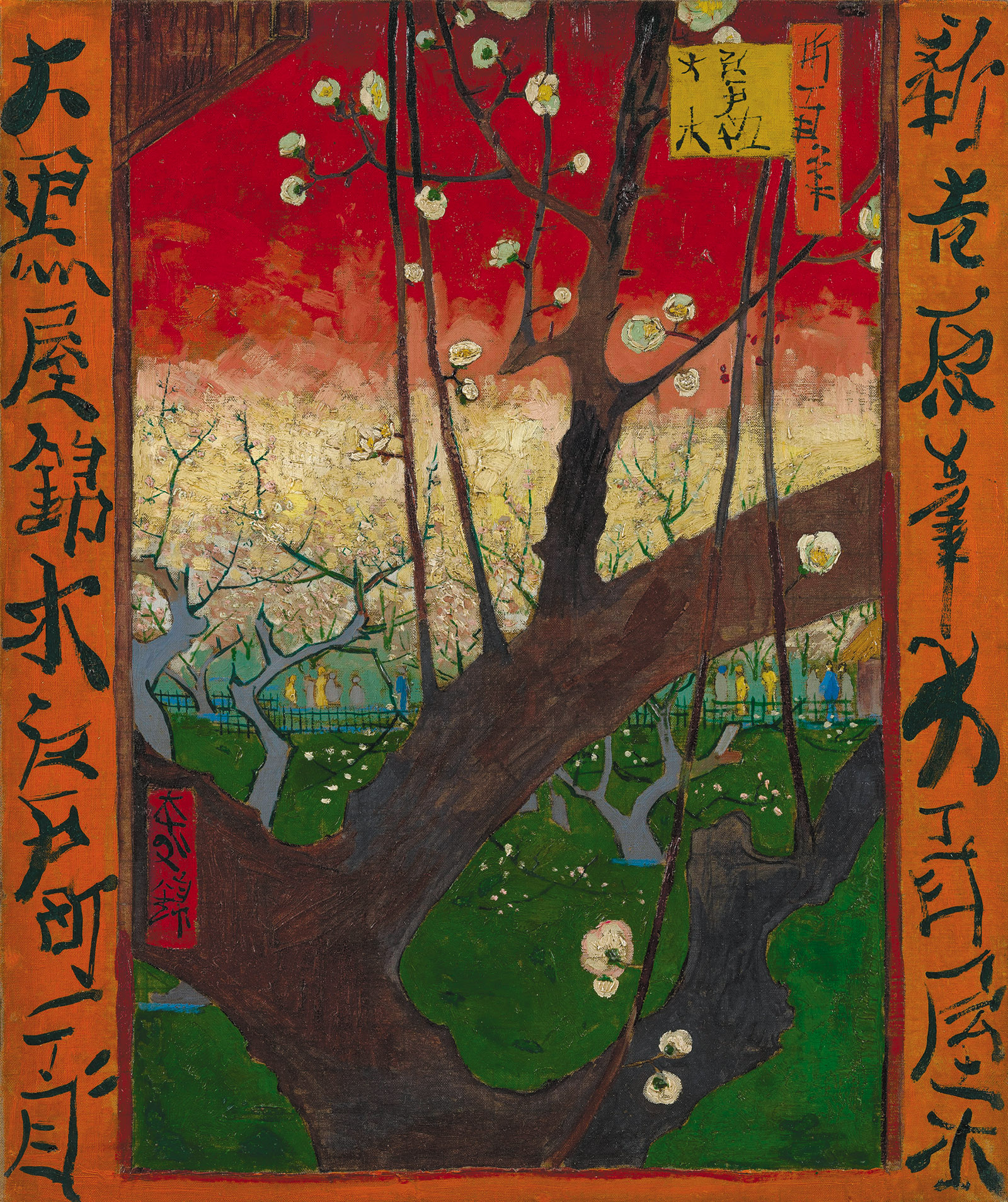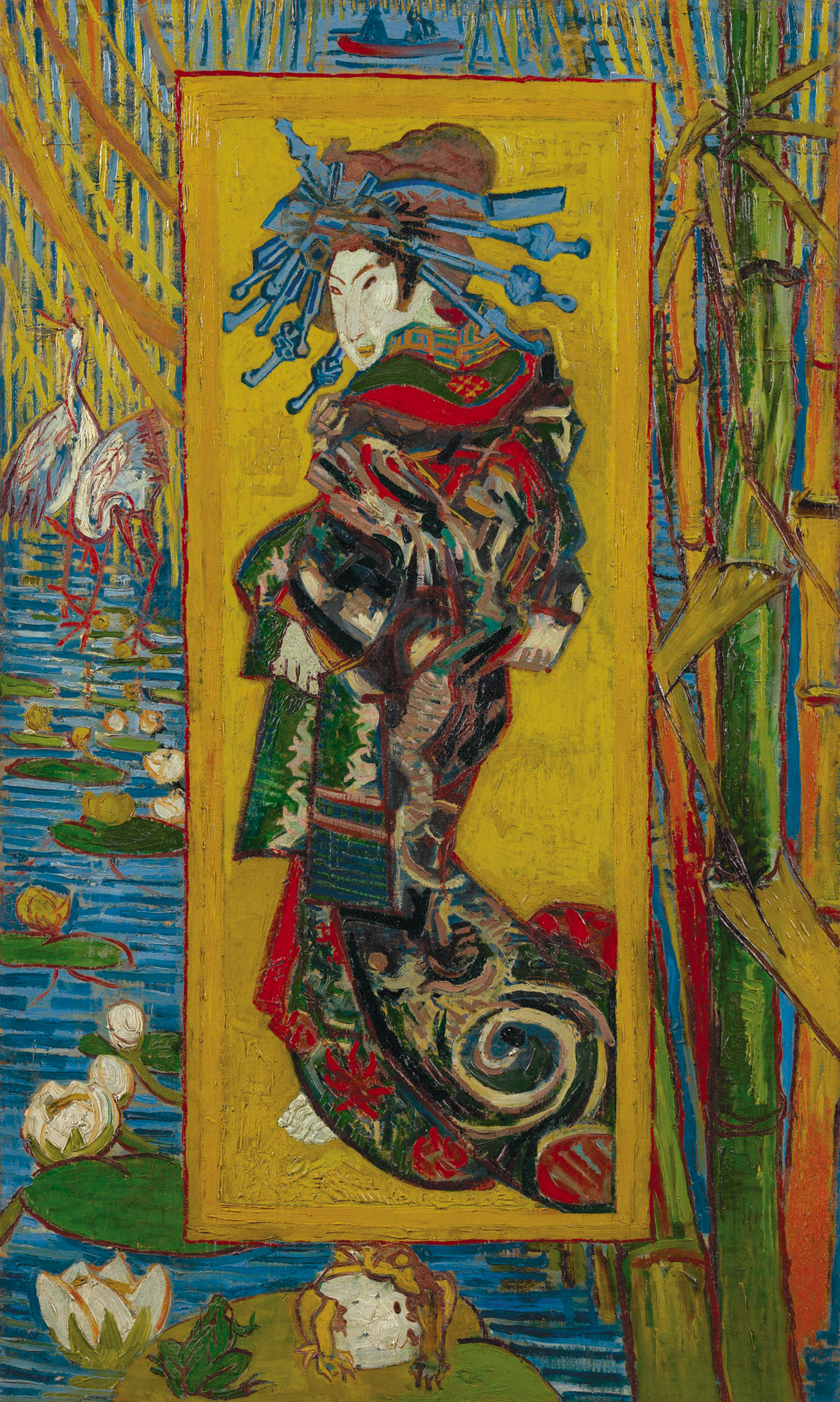When Vincent van Gogh made his momentous decision to leave Paris behind and move to Arles in February 1888, he was determined, at age thirty-four, to remake his art, his personal relationships, and himself, body and soul. Central to this midlife dream of self-transformation was the artist’s surprising conviction that Provence was just like—or as he expressed it, was “the equivalent of”—Japan. As he neared his destination, he peered eagerly out of the train window to ascertain “if it was like Japan yet.” Snow covered the fields when he arrived, not quite what he expected in the sunny South, and yet, as he told his younger brother Theo, an art dealer who was bankrolling the trip along with everything else in Vincent’s feckless life, “the white peaks against a sky as bright as the snow” resembled, in his wishful view, “the winter landscapes the Japanese did.” He rented shabby rooms in what he grandly called the Yellow House and painted the shady denizens of the night café nearby. Every detail of his new life confirmed his conviction: “I’m always saying to myself that I’m in Japan here.”
Of course, Arles was nowhere near Japan, a country that Van Gogh never visited. Nor, for that matter, did any of the other advanced painters of his time who were enthralled with Japanese art—Degas, Monet, Pissarro, and Cassatt, among others. For these artists, Japan meant primarily the world depicted in Japanese woodblock prints: the ukiyo-e or “floating world” images of the pleasure districts of great cities, or the colorful series, by Hokusai and Hiroshige, of famous sights along well-traveled routes, with Mount Fuji or a stylized waterfall in the distance. Van Gogh had first bought such prints in Antwerp, and augmented his collection during his frustrating years in Paris, when he failed to get a foothold in the burgeoning art scene there, either as a painter or as a sometime merchant of the Japanese prints he had accumulated.
Before his departure for Arles, as though revving himself up for his Japanese dream, Van Gogh had painted three arresting imitations of such prints: a lovely reworking of Hiroshige’s popular image of peasants caught in a sudden shower on a bridge; another of blossoming plum trees, also after Hiroshige, in close-up; and most striking of all, an intense reinvention of a floating world courtesan by Eisen. The muted colors of Eisen’s original—quiet greens and mauve exemplifying the discreet chic known in Japan as shibui—undergo a hothouse transformation into Van Gogh’s feverish gold and red. So roughly is the paint applied that the canvas looks more carved than the original woodcut. Van Gogh surrounds the luridly dressed courtesan with a tropical border of water lilies and cranes (or grues—French slang for prostitutes). A fat frog at the bottom looks like a lusty customer waiting to be turned, for a price, into a prince.
In his Japan-inspired portrait of the dealer Père Tanguy, painted around the same time, Van Gogh filled the background with Japanese prints. Tanguy’s hat morphs into the cone of Mount Fuji while his elbow abuts Van Gogh’s courtesan. Flattened by vertical brushstrokes and with a yellow-tinged face, the Buddha-like Tanguy is meant to look Japanese.
Van Gogh planned to surround himself in Arles with a brotherhood of like-minded artists. Having heard that Japanese artists, as a sign of friendship, exchanged artworks with one another, he dedicated a self-portrait to Paul Gauguin, the stockbroker turned vagabond who he hoped would join him in Arles. Van Gogh painted himself as a Japanese monk, “a simple worshipper of the eternal Buddha,” with shaved head and an aquamarine background. “The head is modeled in light-colored thick impasto against a light-colored background with almost no shadows,” he explained. “But I’ve slightly slanted the eyes in the Japanese manner.” Van Gogh had read Pierre Loti’s Madame Chrysanthème, an exotic romance about a naval officer and a geisha in Nagasaki, which partly inspired Madama Butterfly. Loti’s monks, Van Gogh was relieved to find, were not above a little partying on the side. He and Gauguin would be “free to go to the brothel,” he assured Theo, “or to the wine shop if our heart tells us to.”
We all know how this Japanese dream of Van Gogh’s turned out. Gauguin, who sent a self-portrait of himself as a piratical-looking Jean Valjean, accepted the invitation. Painting, boozing, and whoring as Van Gogh had hoped, the two headstrong artists quarreled incessantly. After two months of intense sparring, Van Gogh had a psychotic breakdown—the first of several manic attacks—cut off a portion of his ear (or perhaps, as has been suggested, lost it to Gauguin’s rapier), and hand-delivered the bloody mess, wrapped up like a precious gift, to his favorite prostitute, who promptly fainted. Van Gogh was admitted to the hospital in Arles while Gauguin fled to the South Seas.
Advertisement
And yet part of Van Gogh’s Japan dream did come true. As the contributors to Van Gogh and Japan (published to accompany an exhibition in Tokyo, Kyoto, Sapporo, and Amsterdam) make quite clear, Van Gogh succeeded in transforming his art. Like its title, Van Gogh and Japan is primarily structured around striking juxtapositions. A self-portrait of Van Gogh and his bandaged ear, with a Japanese print in the background, is juxtaposed with the print itself, Geishas in a Landscape: three young women cavorting with fans beside two cranes, with the ubiquitous Fuji in the distance. The cranes, we realize, are the same ones from Van Gogh’s earlier reworking of Eisen. Another juxtaposition aligns his close-up of a crab on its back with a kindred crab of Kunisada’s. Still another links the painted frame of one of his knockout images of sunflowers—favorites of Gauguin—with the similarly decorated borders of his Japanese prints.
One can see in such images how the sustained pressure of Japanese art continued to exert an influence on both Van Gogh’s subject matter and his working methods. “All my work is based to some extent on Japanese art,” he claimed. The gorgeous painting of a seated girl in striped top and polka-dotted skirt, one of the treasures of the National Gallery in Washington, was inspired by his notion of “doll-like” Japanese girls. Van Gogh titled the painting La Mousmé, explaining rather confusedly to Theo, “A mousmé is a Japanese girl—Provençal in this case.” As he learned to look at the world “with a more Japanese eye,” Van Gogh came to believe, expansively, that “Japanese art is something like the primitives, like the Greeks, like our old Dutchmen, Rembrandt, Potter, Hals, Vermeer, Ostade, Ruisdael. It doesn’t end.”
What made such artistic exchanges between Europe and Japan possible, in Van Gogh’s work and in that of his contemporaries, was a network of sophisticated cultural intermediaries: dealers, collectors, scholars, critics, artists. Recent research, which informs the articles by various hands in Japan’s Love for Impressionism, has brought us a better understanding of who such mediators were and what may have motivated them. The most significant was the remarkable Tadamasa Hayashi. A dealer, scholar, and collector, Hayashi had studied French at Tokyo Imperial University and first visited Paris as an interpreter at the World’s Fair of 1878. Such fairs proved an effective venue for Japan, a poor agricultural country struggling to industrialize itself, to present a public face of aesthetic sophistication through its art and handicrafts. After the fair, Hayashi remained in Paris as a dealer specializing in Japanese prints and porcelain.
“The most well-known Japanese person in Paris,” according to former Met curator Colta Ives, Hayashi had a shrewd sense of his clients’ proclivities.1 To Degas he sold risqué manga by Moronobu, along with a dazzling print of geishas bathing in the nude by Kiyonaga, which Degas hung over his bed, in kinky conjunction with a nude drawing by Ingres. Visiting the more respectable Monet at Giverny in 1894, Hayashi, Marianne Mathieu notes, dutifully praised the Rouen Cathedral series—“Your cathedrals, which seem to rise majestically up into the sky, left a deep impression on me”—while providing demur Japanese prints that Monet used to decorate his discreetly painted walls. Hayashi collaborated with Edmond de Goncourt on his books about Hokusai and Utamaro and posed for a portrait, in the form of a Noh mask in bronze, by the sculptor Albert Bartholomé, a friend of Degas, who retained the plaster cast. Hayashi furnished the text for the May 1886 issue of Paris illustré, dedicated to “Le Japon”; on the cover was the Eisen print of the courtesan that Van Gogh transformed.
What made Hayashi so effective as a cultural go-between was that he was every bit as interested in French art as he was in Japanese prints. Through a deliberate policy of exchange—of the kind Van Gogh had imagined for his artistic brotherhood—Hayashi amassed a stunning collection of paintings by Monet, Morisot, Degas, and other artists he admired, which he envisioned housing in a museum of Western art in Tokyo. The year after his return to Japan in 1905, however, Hayashi died, and his collection was dispersed, partly in Japan and then, in a sale in 1913, in New York. Henry Havemeyer, a sugar magnate who had previously purchased Japanese tea boxes from Hayashi, and his wife, Louisine, a passionate admirer of Impressionist art, pounced on some of the highlights, which were later donated to the Met.
Among the works from the Havemeyer hoard that made their way to the Met is Degas’s The Collector of Prints. The painting, which the Havemeyers purchased directly from the artist, may be seen as something of an allegory of the cultural work that men like Hayashi accomplished, along with later collectors like the Yale-educated shipping tycoon Kōjirō Matsukata, who visited Monet several times at his Japanese-style garden at Giverny. He was rewarded for his visits with one of the huge water-lily paintings—hung (upside down) in a charity exhibition for victims of the Great Kantō Earthquake of 1923. Surrounded by the curios of his trade, Degas’s seated collector peers up at us as he fingers a folio of prints; behind him is a framed array of swatches of Japanese textiles, of the kind used to adorn notebooks. The painting itself is structured like a Japanese print, with the various framing devices forming an intricate, abstract array radiating out from the wily collector.
Degas’s painting is a reminder that Japan first entered French art through subject matter, and only later began to influence artistic technique. For La Japonaise, Monet dressed his young wife, Camille, in a blond wig and a red, kimono-like dressing gown. Printed on the fabric was a samurai brandishing his phallic sword just below her waist. Japanese fans adorn the background while she herself coquettishly flutters a European fan. A sexy exoticism pervades the composition, fusing vague fantasies of geisha and samurai with the lore, courtesy of Balzac and Zola, of Parisian courtesans.
Degas and Manet snobbishly eschewed such japoneries, drawing on Japanese art not for trendy subject matter but for the very structure of their paintings. Colta Ives discerns ukiyo-e techniques in Degas’s Portraits in an Office (New Orleans). Nothing in the subject of the painting, which depicts cotton dealers inspecting cotton or reading the newspaper, evokes Japan, but the complex internal framing devices of windows and tables, organizing the isolated figures, suggest the inspiration of Japanese prints. French artists looked to Japanese art for new, unorthodox techniques: the jagged cropping of motifs, odd angles of perspective, flat expanses of color, jarring color contrasts, high horizon lines, and the like. Such experiments were reinforced by other developments, such as photography—Degas was a passionate practitioner—or the vogue for popular imagery drawn from advertising posters. The truncated bow in Monet’s On the Boat would seem to owe as much to photography, concedes Beate Marks-Hanssen, who curated the 2015–2016 exhibit that this book accompanies, as to the Utamaro print juxtaposed with it in Japan’s Love for Impressionism.
As his remarkable letters make clear, Van Gogh wanted something more from Japan and Japanese art than technical innovation. He thought he discerned an entire way of life—more passionate, more devoted to nature, more in line with his own notion of the consoling purpose of art in a world of suffering—in the prints he subjected to such intense scrutiny. As he confided to Theo:
If we study Japanese art, then we see a man, undoubtedly wise and a philosopher and intelligent, who spends his time—on what?—studying the distance from the earth to the moon?—no; studying Bismarck’s politics?—no, he studies a single blade of grass. But this blade of grass leads him to draw all the parts—then the seasons, the broad features of landscapes, finally animals, and then the human figure. He spends his life like that, and life is too short to do everything. Just think of that; isn’t it almost a new religion that these Japanese teach us, who are so simple and live in nature as if they themselves were flowers?
So sophisticated and wide-ranging was Van Gogh’s reading, extending from American classics like Uncle Tom’s Cabin to Dickens and his beloved Zola, that we can’t be entirely confident that he was only thinking of Japanese artists when he zoomed in on that single blade of grass. Was he perhaps channeling the opening lines of Whitman’s Leaves of Grass? “I loafe and invite my soul,/I lean and loafe at my ease observing a spear of summer grass.” To the question, “What is the grass?” Whitman answered, in a way that must have appealed to Van Gogh, “And now it seems to me the beautiful uncut hair of graves.”
During his final months, when Van Gogh, to be closer to Theo, had moved to a guesthouse in Auvers-sur-Oise outside Paris, he had the opportunity to learn about Japan from two artists who had actually been there. The Australian-born painter Edmund Walpole Brooke had lived as a child in Yokohama before studying art in Paris, and the French academic painter Louis-Jules Dumoulin traveled to Japan the same month Van Gogh went to Arles. As the scholar Tsukasa Kōdera notes in a fascinating essay in Van Gogh and Japan, Van Gogh was unimpressed with Brooke’s paintings. Even though “he was brought up in Japan,” he wrote Theo, “you would never think so from his painting.” Dumoulin’s exotic scenes were also apparently a disappointment. For Van Gogh, Japan remained an idealized world, not to be corrected by the perhaps banal reality. After Van Gogh’s suicide in July 1890, Brooke’s business card was found in his sketchbook.
It is often said that Van Gogh only sold one painting—or possibly two—during his life. By the 1920s, however, Auvers had become a pilgrimage site for Japanese visitors, who knew of him primarily from his letters (first published in Japan in book form in 1915), the legend of his life, and reproductions of Japan-inspired works like his portrait of Père Tanguy. “Just as Van Gogh idealized Japan with only limited information about the country,” Kodera notes, “so most Japanese people adored Van Gogh even without seeing his original works.”
Among the Impressionists, the Japanese have a special love for Monet, the name of a chain of hair salons and the subject of wildly popular exhibitions, as Detmar Westhoff notes in Japan’s Love for Impressionism. He suggests, among other factors, the economic prestige accorded by collecting Impressionist paintings and the longing of Japan’s urban dwellers for nature. Monet’s water lilies are given a notably hushed and reverential setting in the architect Tadao Ando’s island museum, the Chichu Art Museum, in Naoshima. And yet Van Gogh would seem to have an almost equally passionate following in Japan.
In his essay on the Armory Show of 1913 and the introduction of modern art to America, Meyer Schapiro distinguished two opposing poles of intensity in modern art. One is the positive intensity initiated by Van Gogh: the pulsing, go-for-broke colors and arresting shapes jangling against each other, as in his sunflowers, his riffs on Japanese prints, or his astonishing Starry Night. The other is a negative intensity, “a search for faint nuances, for an ultimate in delicacy and bareness,” that Schapiro associates with Monet and Whistler. The Japanese love of Van Gogh seems of a different, more personal order than the Monet vogue in Japan, just as Van Gogh would have preferred.
“He was highly appreciated at first by small groups of artists, such as Shirakaba (White Birch), and intellectuals,” according to Kodera, “but gradually came to be idealized and worshipped more widely.” Visits to his grave in Auvers by Japanese pilgrims were interrupted by World War II, after which the intensity of regard and fascination resumed. In 1987, almost exactly one hundred years after Van Gogh painted it in Arles, the Yasuda Insurance Company bought at auction his Sunflowers, a Japan-inspired painting returned to the Land of the Rising Sun.2 The purchase price was an astonishing $40 million, the highest price ever paid for a work of art at auction at that time. But as Van Gogh observed after Gauguin’s departure from Arles, “Money is one kind of coin and painting another.”
This Issue
December 20, 2018
Damn It All
Prodigal Fathers
In the Valley of Fear
-
1
See Colta Ives, “Degas, Japanese Prints, and Japonisme,” in Ann Dumas, Colta Ives, Susan Alyson Stein, and Gary Tinterow, The Private Collection of Edgar Degas (Metropolitan Museum of Art, 1997). ↩
-
2
On the irony of such transactions, see Donald Richie in The Inland Sea (1971; Stone Bridge, 2015), p. 61. “Japan’s love for Monet is extreme,” he notes, but the Japanese “do not realize that it was, in part, through Japanese art that the impressionist school became what it was.” Of Van Gogh’s rendition of a Hiroshige image, he reports, “Recently I saw a Japanese painting that was a copy of the Van Gogh copy of the Hiroshige print.” ↩




